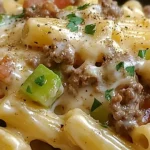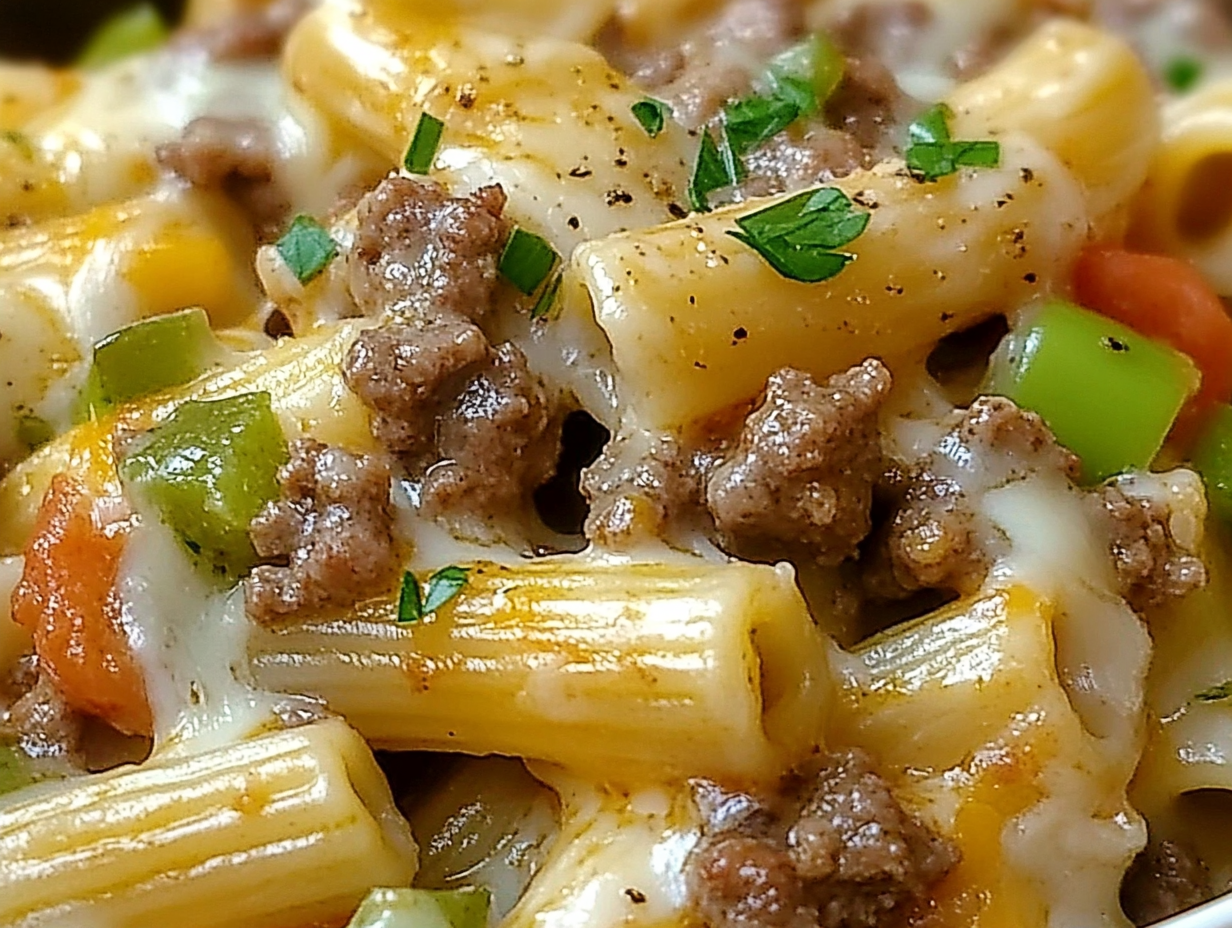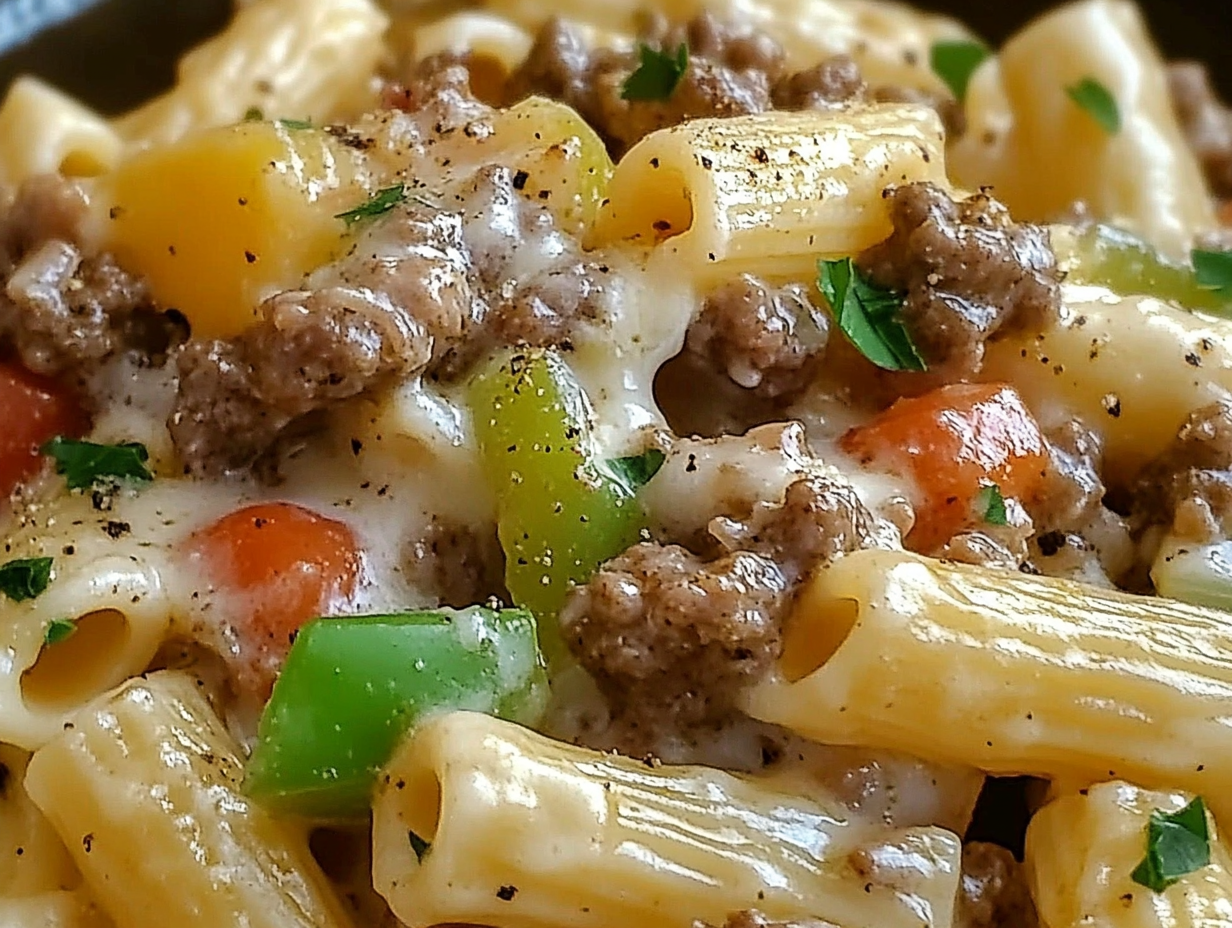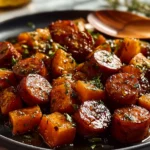Philly Cheesesteak Pasta is a delicious and creative twist on the iconic Philadelphia cheesesteak sandwich, transforming it into a comforting and hearty pasta dish. This recipe brings together the best elements of a classic Philly cheesesteak—tender beef, sautéed onions and green bell peppers, and rich melted cheese—into a creamy, cheesy pasta that’s perfect for satisfying cravings.
While the Philly cheesesteak sandwich is traditionally served on a hoagie roll with thinly sliced steak and melted cheese, this adaptation introduces pasta as the base, making it a more filling and family-friendly dish. The blend of beef, vegetables, and a creamy cheese sauce provides all the flavors of the original sandwich, with the pasta absorbing the savory, tangy goodness.
Origins of Philly Cheesesteak and its Adaptation into Pasta
The Philly cheesesteak was first created in the early 20th century in Philadelphia and has since become a beloved American staple. Traditionally made with thinly sliced beef, melted cheese (usually provolone, Cheez Whiz, or American), and onions, it’s known for its robust, savory flavors.
This recipe for Philly Cheesesteak Pasta takes the classic sandwich ingredients and turns them into a pasta dish that combines the heartiness of a cheesesteak with the comfort of a pasta casserole. The adaptation retains the spirit of the sandwich while adding a creamy pasta twist, creating a meal that’s perfect for cozy dinners.
Why You’ll Love This Recipe
This dish has a creamy, cheesy texture that pairs perfectly with the savory beef and sautéed vegetables, making it irresistibly comforting. It’s a simple and quick meal, ideal for weeknight dinners when you need something filling and flavorful. Plus, the recipe is highly customizable, allowing you to adjust it to your taste, whether you’re looking for a vegetarian option or want to experiment with different cheeses.
Ingredients Breakdown
Meat Choices: Ground Beef vs. Steak Strips
When it comes to making Philly Cheesesteak Pasta, you have the option of using either ground beef or steak strips, each offering a different texture and flavor. Ground beef is convenient, cooks quickly, and easily absorbs the flavors of the other ingredients. It provides a slightly finer texture, making it easier to combine with the pasta and sauce.
On the other hand, steak strips—such as ribeye or sirloin—offer a more authentic Philly cheesesteak experience. Steak strips have a juicier, more pronounced beef flavor and a heartier, chewier texture that complements the dish. The best cuts to use are ribeye, known for its tenderness and marbling, or sirloin, which is leaner but still flavorful.
To achieve that authentic Philly cheesesteak flavor, season the meat with salt, pepper, and, optionally, a dash of garlic powder or Worcestershire sauce. These seasonings enhance the savory richness of the beef, bringing out the classic cheesesteak taste.
The Essential Vegetables: Bell Peppers and Onions
Green bell peppers and onions are staples in Philly cheesesteak recipes, adding sweetness, crunch, and depth of flavor. Green bell peppers, in particular, are preferred for their mild bitterness, which contrasts beautifully with the rich, cheesy sauce. Sautéing the vegetables until soft and fragrant intensifies their flavors and makes them tender enough to blend seamlessly into the pasta dish.
For added flavor complexity, consider including mushrooms or red bell peppers. Mushrooms bring a meaty, umami quality, while red bell peppers add sweetness and a pop of color.
Cheese Choices: Provolone and Cream Cheese
Provolone cheese is ideal for this dish because it melts smoothly, creating that gooey, stringy cheese effect that is synonymous with Philly cheesesteaks. It has a mild, slightly tangy flavor that complements the savory meat and vegetables without overwhelming the dish.
Cream cheese plays a crucial role in making the sauce extra creamy, blending with the broth to create a rich, velvety texture. If you prefer, you can substitute provolone with mozzarella for a milder flavor or cheddar for a sharper taste, though the results will differ slightly.
Pasta Selection: Penne or Rigatoni
Short pastas like penne or rigatoni work best for Philly Cheesesteak Pasta because their hollow centers and ridges help capture the creamy sauce, ensuring each bite is flavorful. These pasta shapes are sturdy enough to hold the thick sauce and support the added weight of the beef and vegetables. To achieve the perfect al dente texture, cook the pasta according to package instructions and test it a minute or two before the suggested time to avoid overcooking.
Beef Broth: The Flavor Enhancer
Beef broth enhances the depth of the sauce, infusing it with a rich, savory flavor that complements the beef and cheese. It also helps thin the cream cheese, making the sauce smooth and luxurious without being too heavy. If you’re looking for alternatives, you can use vegetable broth or chicken broth, though they will alter the flavor profile slightly, making the dish lighter in taste.
Step-by-Step Instructions
1️⃣ Cooking the Pasta
Start by bringing a large pot of salted water to a rolling boil. The general rule is to add 1 tablespoon of salt per 4-6 quarts of water. Salting the water is crucial because it infuses the pasta with flavor from the inside as it cooks. Use enough water so the pasta can move freely and cook evenly.
Once the water reaches a boil, add 12 ounces of your chosen pasta—penne or rigatoni are recommended for this dish. Stir the pasta immediately after adding it to prevent it from sticking. Cook according to the package instructions, usually 9-11 minutes for al dente.
To check for doneness, taste the pasta a minute or two before the recommended cooking time. You want the pasta to be tender but with a slight firmness when bitten, which is key for a perfect al dente texture. Once the pasta is done, drain it and return it to the pot. Avoid rinsing the pasta—this helps the sauce cling better to the noodles.
For extra insurance against sticking, you can toss the drained pasta with a light drizzle of olive oil while it waits to be combined with the sauce.
2️⃣ Sautéing the Vegetables
While the pasta is cooking, start preparing the vegetables. Begin by dicing the green bell pepper and onion into uniform pieces for even cooking. Aim for small, bite-sized pieces that will blend smoothly into the sauce. If you’re adding extra vegetables like mushrooms or red peppers, prepare them the same way.
In a large skillet, heat 1 tablespoon of olive oil over medium heat. Once the oil is hot, add the diced onions and bell peppers. Sauté for 4-5 minutes, stirring occasionally, until they soften and become fragrant. The goal is to cook the vegetables until they are tender but still retain a slight bite—overcooking can make them mushy.
About 1 minute before the vegetables are done, add the minced garlic. Garlic cooks faster than the other vegetables and can easily burn if added too early. Sauté for another minute, just until the garlic becomes aromatic. This last step infuses the dish with a deeper layer of flavor without risking the garlic turning bitter.
3️⃣ Cooking the Meat
Once the vegetables are ready, it’s time to add the meat. If you’re using ground beef, crumble it into the skillet, breaking it up with a spatula as it cooks. Brown the beef for 6-8 minutes over medium heat, stirring frequently to ensure even cooking and prevent large clumps. Cook until the beef is fully browned and no pink remains.
For steak strips, season the strips with salt and pepper before adding them to the skillet. Cook them in a single layer to ensure even browning, stirring occasionally. Steak strips should cook for 4-5 minutes, just until they develop a brown crust on the outside while remaining tender and juicy on the inside.
During this step, season the meat with additional salt, pepper, and, if desired, a dash of garlic powder or Worcestershire sauce to enhance the flavor. Adjust the seasoning to taste.
4️⃣ Creating the Creamy Sauce
With the meat and vegetables cooked, it’s time to create the creamy base for your Philly Cheesesteak Pasta. Add 8 ounces of softened cream cheese to the skillet. It’s important that the cream cheese is at room temperature to help it melt smoothly. Stir constantly to break up the cream cheese and allow it to combine with the meat and vegetables.
Once the cream cheese begins to melt, pour in 1 cup of beef broth. The broth will thin the cream cheese, turning it into a rich, creamy sauce that coats every piece of pasta. Stir the mixture thoroughly until the sauce is smooth and evenly incorporated. If the sauce appears too thick, add a bit more broth, a tablespoon at a time, until it reaches your desired consistency.
Troubleshooting Tips:
- If the cream cheese seems to be curdling, reduce the heat and stir continuously to prevent separation.
- If the sauce is too thin, allow it to simmer for a few minutes to thicken.
5️⃣ Adding Pasta and Broiling
Now that the sauce is ready, stir the cooked pasta into the skillet with the sauce. Toss the pasta until each piece is evenly coated in the creamy cheese mixture. You want the pasta fully integrated with the sauce so that every bite is flavorful.
Once the pasta is well combined, sprinkle 1 cup of shredded provolone cheese evenly over the top. For the final touch, place the skillet under the broiler for 3-5 minutes, just until the cheese is melted, bubbly, and golden brown. Keep a close eye on the broiling process, as the cheese can burn quickly if left unattended.
Tip: Rotate the skillet halfway through broiling to ensure even browning across the top of the dish.
6️⃣ Serving the Dish
After broiling, remove the skillet from the oven and allow it to cool for a minute before serving. This gives the cheese time to set slightly, making it easier to dish out.
For a visually appealing presentation, serve your Philly Cheesesteak Pasta in shallow bowls or plates. Garnish with a sprinkle of fresh parsley or a light dusting of grated parmesan for added color and flavor.
This dish pairs beautifully with a crisp green salad or warm garlic bread to balance the richness of the pasta. If you have leftovers, store them in an airtight container in the refrigerator for up to 3 days. When reheating, add a splash of broth or water to restore the sauce’s creamy consistency. Heat gently in a skillet over medium-low heat or microwave in short intervals, stirring occasionally to avoid drying out the pasta.
Customizations and Variations
Meat Substitutions
If you’re looking to make this Philly Cheesesteak Pasta vegetarian, there are a few excellent alternatives to traditional beef. Mushrooms are a fantastic substitute because of their meaty texture and umami flavor. Sauté mushrooms with the onions and bell peppers to add depth to the dish. Another option is using plant-based meat substitutes, which mimic the texture of ground beef or steak strips while keeping the dish meat-free. Popular brands of plant-based meats can be easily incorporated into the recipe, cooking them the same way as ground beef.
For those who want a lighter version, you can swap the beef for ground turkey or chicken breast strips. These leaner meats still provide protein but are lower in fat, making for a healthier dish. Be sure to season them well with salt, pepper, and garlic to boost the flavor.
If you like a bit of heat, consider adding jalapeños or a sprinkle of red pepper flakes while cooking the vegetables. This will give the dish a spicy kick that complements the creamy cheese sauce.
Cheese Variations
While provolone is traditional for a Philly cheesesteak, you can easily swap it for other cheeses. Mozzarella melts beautifully and has a mild flavor, while cheddar provides a sharper, tangier taste. If you want a cheesier dish, consider doubling the cheese amount or adding a layer of parmesan for extra richness and a bit of nuttiness.
Pasta Alternatives
To make this dish healthier, you can use whole wheat pasta, which adds fiber and a slightly nutty flavor. For those with gluten sensitivities, gluten-free pasta works just as well, provided you follow the cooking instructions to avoid overcooking.
If you want to experiment with different shapes, try fusilli, ziti, or farfalle. These pasta shapes have ridges and curves that hold the creamy sauce beautifully, just like penne or rigatoni.
Nutritional Information and Tips for a Healthier Version
Nutritional Breakdown of the Recipe
A typical serving of Philly Cheesesteak Pasta is packed with flavor, but it’s also quite indulgent. On average, one serving (based on a recipe serving four) can contain approximately 600-700 calories, 30-40 grams of fat, 30-35 grams of protein, and 50-60 grams of carbohydrates. These numbers can vary depending on the specific ingredients and amounts used.
To manage portion sizes without sacrificing flavor, serve smaller portions (about 1 cup per person) alongside a side salad or steamed vegetables. This allows you to enjoy the dish while maintaining balance in your meal.
Healthier Adjustments
To reduce calories and fat, consider using light cream cheese instead of full-fat cream cheese. This cuts down on the richness while still keeping the sauce creamy. Opting for lean meats, such as ground turkey, chicken breast, or even plant-based alternatives, can significantly lower the fat content while keeping the dish flavorful and protein-rich.
You can also swap full-fat cheeses for reduced-fat provolone or mozzarella without compromising too much on flavor. Additionally, incorporating more vegetables like spinach or zucchini into the dish not only adds nutrients but also increases the fiber content, making the meal more filling and balanced while keeping the calorie count lower.
FAQs
Can I use different types of pasta?
Yes, you can definitely use different types of pasta in this dish! Short pasta shapes like penne, rigatoni, fusilli, and ziti work particularly well because they hold the sauce and cheese effectively. These shapes have ridges or hollow centers that capture the creamy sauce, ensuring each bite is flavorful. Farfalle (bow-tie) pasta can also be a fun alternative. However, avoid using long pasta like spaghetti or linguine since they don’t hold the sauce as well and can become messy when mixed with the thick, cheesy sauce.
What kind of cheese can I use instead of provolone?
If you don’t have provolone, you can substitute it with other melting cheeses. Mozzarella is a great alternative for its mild flavor and excellent meltability. American cheese can give the dish a creamier texture and a slightly processed, nostalgic flavor that many associate with cheesesteaks. Cheddar works if you want a sharper taste, though it will make the dish slightly tangier. For extra creaminess, you can also mix in cream cheese or cheddar along with your chosen cheese.
Can I prepare this dish ahead of time?
Yes, Philly Cheesesteak Pasta can be prepared ahead of time. After cooking, allow the pasta to cool before transferring it to an airtight container. It can be stored in the refrigerator for up to 3 days. When reheating, add a splash of beef broth or water to loosen the sauce and prevent it from drying out. Heat gently in a skillet or in the microwave, stirring occasionally.
How do I make this recipe gluten-free?
To make this dish gluten-free, use gluten-free pasta made from rice, corn, or quinoa. Ensure that your other ingredients, such as beef broth, are certified gluten-free, as some processed broths may contain hidden gluten.
Is there a way to make this dish dairy-free?
Yes, you can make this recipe dairy-free by using dairy-free cream cheese and a plant-based cheese substitute like vegan provolone or mozzarella. Many brands offer dairy-free cheeses that melt well, ensuring you can still enjoy a creamy, cheesy texture. Be sure to check that all ingredients, including the broth, are also dairy-free.
Conclusion and Final Tips
Philly Cheesesteak Pasta is the perfect combination of comfort and indulgence, making it a crowd-pleasing dish that appeals to a wide range of tastes. With its rich, creamy sauce, savory beef, and sautéed vegetables, this pasta delivers all the classic flavors of a Philly cheesesteak in a form that’s easy to prepare and serve. The combination of gooey provolone and soft cream cheese ensures a deliciously creamy texture, while the pasta provides a hearty base that makes this meal satisfying for lunch or dinner.
One of the best things about this recipe is how adaptable it is. Don’t hesitate to experiment with different meats, cheeses, and vegetables to suit your preferences. You can easily swap out ingredients to make it lighter, spicier, or vegetarian. With simple tweaks, this dish can fit into any dietary need, making it versatile enough for your weekly meal rotation.
For a balanced meal, serve Philly Cheesesteak Pasta with a fresh green salad or garlic bread. Its creamy, savory nature pairs well with lighter sides. Leftovers can be stored and reheated, making this recipe a great choice for meal prepping or busy weeknights when you want a comforting, homemade meal with minimal effort.
Print
Philly Cheesesteak Pasta
Description
This hearty and creamy beef pasta dish is packed with flavor and perfect for a quick, comforting meal. It combines savory beef, sautéed veggies, and creamy cheese sauce, all topped with gooey provolone. A true comfort food hit that can be whipped up in no time!
Ingredients
- 1 lb ground beef or steak strips
- 1 green bell pepper, diced
- 1 onion, diced
- 2 cloves garlic, minced
- 8 oz cream cheese, softened
- 1 cup shredded provolone cheese
- 12 oz pasta (penne or rigatoni recommended)
- 1 cup beef broth
- Salt and pepper to taste
- 1 tbsp olive oil
Instructions
1️⃣ Cook the Pasta:
Bring a large pot of salted water to a boil. Add the pasta and cook until al dente according to the package instructions. Drain and set aside.
2️⃣ Sauté the Vegetables:
In a large skillet, heat the olive oil over medium heat. Add the diced green bell pepper, onion, and minced garlic. Sauté for 4-5 minutes, or until the vegetables are softened and fragrant.
3️⃣ Cook the Meat:
Add the ground beef or steak strips to the skillet. Cook, breaking up the beef as necessary, until the meat is fully browned and cooked through. Season with salt and pepper to taste.
4️⃣ Combine Ingredients:
Stir the softened cream cheese and beef broth into the skillet with the meat and vegetables. Continue to cook, stirring constantly, until the cream cheese is fully melted and the mixture is smooth and creamy.
5️⃣ Top with Cheese and Broil:
Add the cooked pasta to the skillet, tossing it in the sauce until fully coated. Sprinkle the shredded provolone cheese evenly on top. Broil in the oven for 3-5 minutes, or until the cheese is melted, bubbly, and golden brown.
6️⃣ Serve:
Remove from the oven and serve hot. Enjoy this creamy, cheesy, and savory pasta dish immediately!
Notes
- For a richer flavor, use steak strips instead of ground beef.
- You can swap the green bell pepper for red or yellow for a sweeter taste.
- This dish is perfect for leftovers! Simply store in an airtight container and reheat in the oven or microwave.





